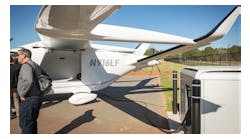PortsToronto Releases 2016 Noise Management Report for Billy Bishop Toronto City Airport
PortsToronto, the owner and operator of Billy Bishop Toronto City Airport (Billy Bishop Airport), on Feb. 2, released the airport's 2016 annual Noise Management Report, a compilation of all noise data submitted to the airport’s Noise Management Office over the course of the year. Overall complaints decreased by 38 per cent, from 386 complaints in 2015 to 236 complaints in 2016, due in large part to efforts to develop enhanced programs, procedures and infrastructure aimed at mitigating the airport's noise impact on the surrounding community.
Complaints related to the ferry and mainland operations declined by a significant 89 per cent, going from 26 complaints in 2015 to just three complaints in 2016. Further, 99 per cent of the complaints received by the airport’s Noise Management Office were handled within the five-day window that Billy Bishop Airport adheres to as part of PortsToronto’s commitment to being a responsive member of the waterfront community.
The Noise Management Report follows on the heels of the 2015 Noise Exposure Contour compliance Report conducted by Transport Canada that confirms that Billy Bishop Airport continues to operate within its strict Noise Exposure Forecast (“NEF”) as required under the Tripartite Agreement. This has been the case with all previously commissioned reports dating back to 2008.
“Operating an airport that is part of a thriving, mixed-use urban waterfront requires the right balance to ensure that operations keep pace with the surrounding community and that measures are in place to mitigate the impacts associated with running a successful airport,” said Gene Cabral, Executive Vice President of PortsToronto and Billy Bishop Toronto City Airport. “In 2016, we once again worked together with the community to identify solutions that assist with our noise reduction efforts and successfully implemented new noise mitigation infrastructure at Billy Bishop Airport such as upgrading the airport’s Noise Monitoring Terminals (NMTs) while resurfacing the runway. In 2017, these efforts will reach a new level as we open and begin utilizing our new Ground Run-up Enclosure, which will only be the second of its kind in Canada.”
In 2016, the following measures were developed and implemented by PortsToronto to further mitigate the airport’s noise impact on the surrounding community:
- The launch of an enhanced free airport shuttle service with live tracking capabilities that drops-offs/picks-up passengers outside the mainland pavilion and provides travellers with reliable transport to and from the airport which has reduced car traffic and related noise
- Upgrading the airport’s two NMTs to the latest technology to further enhance the ability to monitor noise generated by the airport’s operations, as well as adding a third NMT on the mainland ferry terminal building that enables enhanced tracking of noise generated by aircraft run-ups and the airport’s ferry operations
- Continuing to offer free access to Webtrak, an Internet-based software service that enables individuals to locate and track an aircraft they hear flying overhead from their computer, smartphone or tablet
- Continuing to use Vortex – a customizable tracking and logging software platform designed specifically for an airport environment – which has enabled the airport’s Noise Management Office to track complaints received online, by phone or email, and assisted staff in addressing the complaint quickly and efficiently
- Encouraging passengers to walk, bike or take public transit to the airport to decrease the number of vehicles in the surrounding airport community and further mitigate the airport’s noise impact from traffic. This campaign has been successful with 40 per cent of travellers walking, biking or taking transit to and from the airport, even making the airport bike station at the Bathurst Street/Eireann Quay intersection within the top ten busiest stations in the city’s network.
It is particularly significant that the year 2016 saw a substantial decrease in noise-related complaints given that a large-scale, overnight airfield rehabilitation project has been underway since June. The project to replace the existing aging civil and electrical infrastructure (pavements and lighting) for the airport’s runways, taxiways and apron areas, also involves the construction of a Ground Run-up Enclosure (GRE) to dampen the acoustic impact from engine run-ups which are required and regulated as part of standard aircraft maintenance.
Another important infrastructure project that continues to deliver on its promises is the pedestrian tunnel that was opened in July 2015. The tunnel, which gives passengers the option to walk between the mainland and the airport 100-feet beneath the surface of Lake Ontario, has effectively improved mainland ground traffic and passenger flow and has entirely eliminated pressure points for travellers and surges in traffic demand at the mainland terminal and along Eireann Quay.
The results highlighted in the 2016 Noise Management Report are significant given the airport’s continued rise in popularity. In 2016, Billy Bishop Airport welcomed 2.7 million passengers – representing a nine percent increase in passenger numbers over 2015 under PortsToronto’s managed growth strategy to ensure balance along the waterfront.

